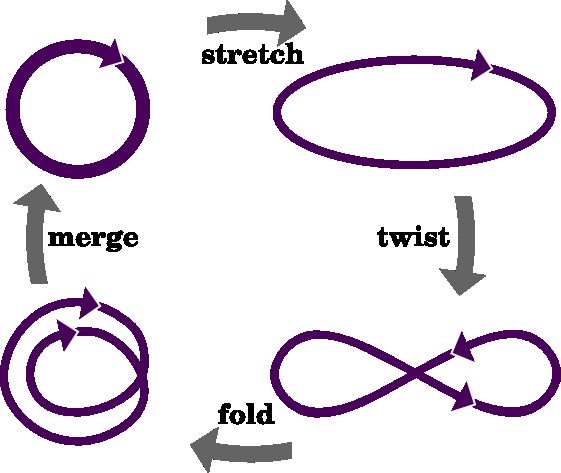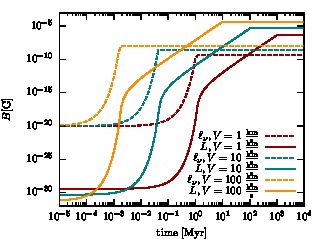My Research
In my PHD project I study the evolution of cosmic magnetic fields. For this I use semi-analytical calculations to model the so-called turbulent dynamo and its role in the early Universe.
What is a "turbulent dynamo"?

Figure 1: The stretch-twist-fold model as
an illustration of the turbulent dynamo.
an illustration of the turbulent dynamo.
The mechanism is based on the fact that the magnetic field becomes stronger when the field lines are stretched. Figure 1 illustrates the stretching, twisting and folding of the field lines schematically. The trigger of the stretching is turbulence, i.e. chaotic motion on a large range of scales, in a weakly magnetized plasma.
We use an analytical description to predict the properties of the turbulent dynamo and the evolution of the magnetic field. Our model takes into account various astrophysical environments, for example different types of turbulence and different microphysical quantities.
How does the turbulent dynamo operate in the early Universe?

Figure 2: Typical evolution scenarios of the magnetic
field strength for different properties of the turbulence.
field strength for different properties of the turbulence.
During the formation of the first stars and galaxies turbulence is driven efficiently by accretion and supernova explosions. These turbulent motions stretch the field lines and by this amplify the field in the turbulent dynamo mechanism. Now the magnetic field grows exponentially with a typically very large growth rate. With our models we find that strong magnetic fields of the order of 10-6 Gauss, which is comparable to the present-day Milky Way value, can be generated by the turbulent dynamo. The amplification takes place within a few 107 years, which is short compared to other dynamical timescales of the systems. A typical evolution of the magnetic field strength is shown in figure 2.
Which consequences do strong magnetic fields have in the epoch of the first stars and galaxies?
We know that magnetic fields play an important role in the present-day Universe. For example they initiate jets and matter outflows of stars and add an additional pressure in the interstellar medium, which influences star formation strongly.In principle the effects of magnetic fields during the formation of the first stars and galaxies should be similar. For exploring the influence of magnetic fields on the primordial Universe numerical simulations will be an important tool.
Responsible: Simon Glover, last modification Jan/15/2014 17:59 CET
